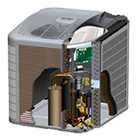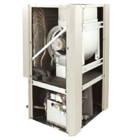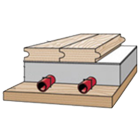Solutions

Air Source Heat Pumps
Electric air-to-air heat pumps are basically reversible air conditioners. They move heat from the air in one location to the air in another. In summer, they operate as air conditioners, removing heat from the home. In winter, they reverse their operation, gathering heat from air outside the home and moving it inside. Most heat pumps deliver conditioned air to the home using ductwork, although packaged, through-the-wall systems with no duct work are available.
Since heat pumps move rather than generate heat, they can be extremely efficient, delivering more than three times as much heat as they consume in energy.

Geothermal Heat Pumps
Geothermal heat pumps are similar to ordinary heat pumps, but use the ground instead of outside air to provide heating, air conditioning and, in most cases, hot water. Because they use the earth’s natural heat, they are among the most efficient and comfortable heating and cooling technologies currently available.
Geothermal heat pumps (sometimes referred to as GeoExchange, earth-coupled, ground-source, or water-source heat pumps) have been in use since the late 1940s. Geothermal heat pumps (GHPs) use the constant temperature of the earth as the exchange medium instead of the outside air temperature. This allows the system to reach fairly high efficiencies (300%-600%) on the coldest of winter nights, compared to 175%-250% for air-source heat pumps on cool days.
While many parts of the country experience seasonal temperature extremes — from scorching heat in the summer to sub-zero cold in the winter — a few feet below the earth’s surface the ground remains at a relatively constant temperature. Like a cave, this ground temperature is warmer than the air above it during the winter and cooler than the air in the summer. The heat pump takes advantage of this by exchanging heat with the earth through a ground heat exchanger.

Radiant Floor Heat
Radiant floor heat has become a popular supplement of traditional heating systems. The spacing of the water-filled tubing or electric heat elements produce a consistent amount of heat from the floor level. It uses the entire floor as a radiator, surrounding people and objects with warm air near the floor. The heating source for the water can be as simple as a traditional water heater. For larger applications, a boiler might be a consideration.
There are a number of different applications that can be used. For new construction, the water tubing can be installed above the sub-floor (as seen below). For existing homes, the tubing can be installed in the joist-spaces below the floor. Insulation is then placed beneath that tubing to project the heat upwards towards the floor to be heated.
